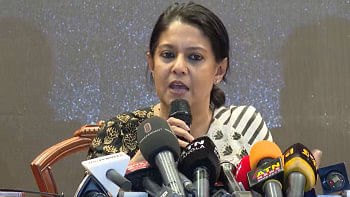Plight of the haor people
The struggles of the people living in the haor areas of the country's north-eastern districts came to light during the early flash floods of 2017.
Triggered by heavy rainfall, these flash floods caused a disastrous situation for more than eight lakh families living in six districts of the haor area. Covid-19 pandemic has only exacerbated the problem.
Department of Bangladesh Haor and Wetlands Development (DBHWD) has taken several projects to improve the lives and livelihood of the marginalised people of the haor region. However, these projects are failing to achieve their goal due to lack of transportation, proper communication, access to information and, the inclusion of community members in the planning and implementation process.
The master plan for haor areas , prepared by DBHWD in 2012, focuses on developing water resources, agriculture, fisheries, livestock, transportation, social services, and industry. This plan also includes 36 critical projects for haor areas, some already completed and some currently being implemented.
However, the DBHWD does not have proper monitoring and evaluation tools to understand the impact of these initiatives on the lives of the intended beneficiaries.
"Some projects have been completed, but no impact assessment has been conducted. Once all the projects from the 'Master Plan' are completed, we will initiate a detailed assessment which will help upgrade the plan and set a baseline for future projects," said Dr Ali Muhammad Omar Faruque, Director of Agriculture, Water & Environment at DBHWD.
Community engagement is crucial to address this gap, opined Towfiqul Islam Khan, Senior Research Fellow of CPD.
"Without key insight from the local perspective, a top-down approach will rarely succeed in producing long-term sustainable development. This is why citizen-led social audits and public hearings for local development projects are highly successful. They allow communities to take ownership of the projects being implemented and ensure accountability from these projects. Citizen-led audits should be institutionalised at the local government level to ensure that initiatives put in place for farmers and fishers are actually being implemented for their betterment and not just being exploited by influential middlemen." he added.
Lack of accessibility is another major barrier for the haor people. This include a lack of awareness among farmers and fishers regarding government services, lack of direct communication with key officials, lack of human resources in service sectors, inadequate training, unavailability of farm materials and equipment and lack of access to agriculture loans.
Due to the unique geographical structure, around 83 percent of the people in Sunamganj depend directly and indirectly on agriculture and fishing. Yet, this district suffers the most due to accessibility issues.
"Farmers are rarely getting training from government projects. Most of the time, they are getting training from projects which are not directly related to their field of work," said Faridul Hasan, Deputy Director of the Department of Agriculture Extension (DAE) in Sunamganj.
"However," he continued, "we are trying to monitor and ensure fertiliser distributors are making sales at government-subsidised rates in each union. But many important types of machinery required for farming are still unavailable for these farmers."
Towfiqul Islam Khan said, "Three issues must be considered to maintain accountability in government projects and services meant for the haor people.
"Firstly, projects and services must be tailor-made for farmers and fishers of the haor. Secondly, service coverage must reach all sectors—agriculture, health, education, etc.—and lastly, general people must be involved in the implementation of the service delivery."
He further suggested, "Union Digital Centres should be better utilised to allow local people to access various information and public services."
The DAE also suffers from a lack of human resources, as 93 sub-assistant agriculture officers are currently working in Sunamganj, even though a total of 263 positions are available.
The DAE officials also suggest that the government build more submersible roads in the haor, which will significantly help solve the accessibility issue.
Somehow, even against these unfavourable odds, farmers of Sunamganj have excelled in Boro production and exceeded the target of 885,229 tonne rice production this year.
However, they rarely get a fair price for their harvest.
Nakib Saad Saiful Islam, the District Controller of food in Sunamganj, said, "The price of paddy in the market is still lower than the government rate of Tk 27 per kg."


 For all latest news, follow The Daily Star's Google News channel.
For all latest news, follow The Daily Star's Google News channel. 



Comments